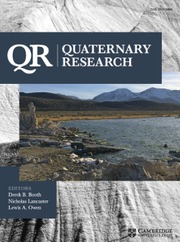Crossref Citations
This article has been cited by the following publications. This list is generated based on data provided by
Crossref.
Soon, Willie W.-H.
2009.
Solar Arctic-Mediated Climate Variation on Multidecadal to Centennial Timescales: Empirical Evidence, Mechanistic Explanation, and Testable Consequences.
Physical Geography,
Vol. 30,
Issue. 2,
p.
144.
Fujine, Kazuho
Tada, Ryuji
and
Yamamoto, Masanobu
2009.
Paleotemperature response to monsoon activity in the Japan Sea during the last 160kyr.
Palaeogeography, Palaeoclimatology, Palaeoecology,
Vol. 280,
Issue. 3-4,
p.
350.
Zhou, Houyun
Feng, Yue-xing
Zhao, Jian-xin
Shen, Chuan-Chou
You, Chen-Feng
and
Lin, Yin
2009.
Deglacial variations of Sr and 87Sr/86Sr ratio recorded by a stalagmite from Central China and their association with past climate and environment.
Chemical Geology,
Vol. 268,
Issue. 3-4,
p.
233.
Jo, Kyoung-nam
Woo, Kyung Sik
Cheng, Hai
Edwards, Lawrence R.
Wang, Yongjin
Kim, Ryeon
and
Jiang, Xiuyang
2010.
Textural and carbon isotopic evidence of monsoonal changes recorded in a composite-type speleothem from Korea since MIS 5a.
Quaternary Research,
Vol. 74,
Issue. 1,
p.
100.
Zhou, HouYun
Wang, Yue
Huang, LiuYuan
and
Mai, ShangQuan
2011.
Speleothem Mg, Sr and Ba records during the MIS 5c-d, and implications for paleoclimate change in NE Sichuan, Central China.
Chinese Science Bulletin,
Vol. 56,
Issue. 32,
p.
3445.
Zhou, Houyun
Zhao, Jianxin
Qing, Wang
Feng, Yuexing
and
Tang, Jing
2011.
Speleothem‐derived Asian summer monsoon variations in Central China, 54–46 ka.
Journal of Quaternary Science,
Vol. 26,
Issue. 8,
p.
781.
Zhou, Xin
2012.
Asian monsoon precipitation changes and the Holocene methane anomaly.
The Holocene,
Vol. 22,
Issue. 7,
p.
731.
Liew, Ping-Mei
Chen, Bing-Cheng
Hsieh, Meng-Long
Huang, Shu-Yue
and
Lee, Cheng-Yi
2013.
Decreasing intensity of the last glacial stadials in low latitude terrestrial East Asia inferred by a new observation of pollen records in central Taiwan.
Journal of Asian Earth Sciences,
Vol. 69,
Issue. ,
p.
159.
Zhang, Weihong
Wu, Jiangying
Wang, Yi
Wang, Yongjin
Cheng, Hai
Kong, Xinggong
and
Duan, Fucai
2014.
A detailed East Asian monsoon history surrounding the ‘Mystery Interval’ derived from three Chinese speleothem records.
Quaternary Research,
Vol. 82,
Issue. 1,
p.
154.
Jiang, Xiuyang
Wang, Xiaoyan
He, Yaoqi
Hu, Hsun-Ming
Li, Zhizhong
Spötl, Christoph
and
Shen, Chuan-Chou
2016.
Precisely dated multidecadally resolved Asian summer monsoon dynamics 113.5–86.6 thousand years ago.
Quaternary Science Reviews,
Vol. 143,
Issue. ,
p.
1.
Atsawawaranunt, Kamolphat
Comas-Bru, Laia
Amirnezhad Mozhdehi, Sahar
Deininger, Michael
Harrison, Sandy P.
Baker, Andy
Boyd, Meighan
Kaushal, Nikita
Ahmad, Syed Masood
Ait Brahim, Yassine
Arienzo, Monica
Bajo, Petra
Braun, Kerstin
Burstyn, Yuval
Chawchai, Sakonvan
Duan, Wuhui
Hatvani, István Gábor
Hu, Jun
Kern, Zoltán
Labuhn, Inga
Lachniet, Matthew
Lechleitner, Franziska A.
Lorrey, Andrew
Pérez-Mejías, Carlos
Pickering, Robyn
and
Scroxton, Nick
2018.
The SISAL database: a global resource to document oxygen and carbon isotope records from speleothems.
Earth System Science Data,
Vol. 10,
Issue. 3,
p.
1687.
Zhang, Haiwei
Ait Brahim, Yassine
Li, Hanying
Zhao, Jingyao
Kathayat, Gayatri
Tian, Ye
Baker, Jonathan
Wang, Jian
Zhang, Fan
Ning, Youfeng
Edwards, R. Lawrence
and
Cheng, Hai
2019.
The Asian Summer Monsoon: Teleconnections and Forcing Mechanisms—A Review from Chinese Speleothem δ18O Records.
Quaternary,
Vol. 2,
Issue. 3,
p.
26.
Corrick, Ellen C.
Drysdale, Russell N.
Hellstrom, John C.
Capron, Emilie
Rasmussen, Sune Olander
Zhang, Xu
Fleitmann, Dominik
Couchoud, Isabelle
and
Wolff, Eric
2020.
Synchronous timing of abrupt climate changes during the last glacial period.
Science,
Vol. 369,
Issue. 6506,
p.
963.
Zhang, Xin
Xiao, Haiyan
Chou, Yu-Chen
Cai, Binggui
Lone, Mahjoor Ahmad
Shen, Chuan-Chou
and
Jiang, Xiuyang
2020.
A detailed East Asian monsoon history of Greenland Interstadial 21 in southeastern China.
Palaeogeography, Palaeoclimatology, Palaeoecology,
Vol. 552,
Issue. ,
p.
109752.
Zhang, Xin
Jiang, Xiuyang
Xiao, Haiyan
Cai, Binggui
Yu, Tsai-Luen
and
Shen, Chuan-Chou
2021.
A gradual transition into Greenland interstadial 14 in southeastern China based on a sub-decadally-resolved stalagmite record.
Quaternary Science Reviews,
Vol. 253,
Issue. ,
p.
106769.
Dong, Jinguo
Shen, Chuan-Chou
Wang, Yi
Hu, Hsun-Ming
Banerjee, Yogaraj
and
Huang, Wei
2022.
Multicentennial to millennial–scale changes in the East Asian summer monsoon during Greenland interstadial 25.
Quaternary Research,
Vol. 109,
Issue. ,
p.
195.
Shi, Xiao
Yang, Yan
Cheng, Hai
Zhao, Jingyao
Li, Ting-Yong
Lei, Lidan
Liang, Sha
Feng, Xiangxiang
and
Edwards, R. Lawrence
2022.
Influences on Asian summer monsoon during Dansgaard-Oeschger events 19 to 25 (70–115 kyr B.P.).
Palaeogeography, Palaeoclimatology, Palaeoecology,
Vol. 587,
Issue. ,
p.
110798.




